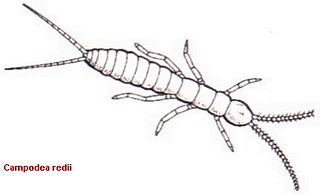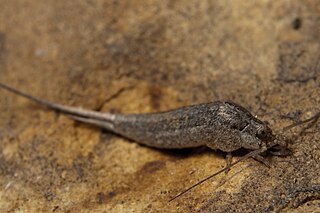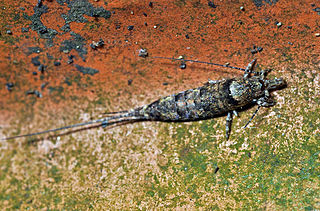
Zorotypus is a genus of angel insects in the family Zorotypidae.

The Archaeognatha are an order of apterygotes, known by various common names such as jumping bristletails. Among extant insect taxa they are some of the most evolutionarily primitive; they appeared in the Middle Devonian period at about the same time as the arachnids. Specimens that closely resemble extant species have been found as both body and trace fossils in strata from the remainder of the Paleozoic Era and more recent periods. For historical reasons an alternative name for the order is Microcoryphia.

The Machilidae are a family of insects belonging to the order Archaeognatha. There are around 450 described species worldwide. These insects are wingless, elongated and more or less cylindrical with a distinctive humped thorax and covered with tiny, close-fitting scales. The colour is usually grey or brown, sometimes intricately patterned. There are three "tails" at the rear of the abdomen: two cerci and a long central epiproct. They have large compound eyes, often meeting at a central point. They resemble the silverfish and the firebrat, which are from a different order, Zygentoma.

Lepismatidae is a family of primitive wingless insects with about 190 described species. This family contains the two most familiar members of the order Zygentoma: the silverfish and the firebrat. It is one of five families in the order Zygentoma.

Ctenolepisma is a genus of primitive insects in the order Zygentoma, closely related to the silverfish and firebrat but less reliant on human habitation, some species being found both indoors and outdoors and some found exclusively outdoors. The genus is distributed nearly worldwide in warm regions. Australia lacks native Ctenolepisma, but is home to introduced species.

The Campodeidae are a family of hexapods belonging to the order Diplura. These pale, eyeless hexapods, the largest of which grow to around 12 mm in length, can be recognised by the two long, many-segmented cerci at the end of the abdomen. Abdominal spiracles are absent.
Japyx is a genus of diplurans belonging to the family Japygidae. These eyeless, predatory hexapods largely shun direct sunlight, remaining under stones and among detritus, where they use pincer-like cerci to catch their tiny prey.

The Margarodidae or ground pearls are a family of scale insects within the superfamily Coccoidea. Members of the family include the Polish cochineal and Armenian cochineal and the original ground pearl genus, Margarodes. Beginning in 1880, a number of distinct subfamilies were recognized, with the giant coccids being the first. Although Maskell proposed a new family, many continued to regard the monophlebids as a mere subfamily for many years, and the Margarodidae classification continued to be polyphyletic through the 20th Century. Since then, taking the advice of Koteja several subfamilies and tribes have been elevated into their own families such as Matsucoccidae and Xylococcidae. The pared-down family of Margarodidae is monophyletic.

The Meinertellidae are a small family of basal insects belonging to the order Archaeognatha. They are sometimes known as rock bristletails. These insects can be distinguished from members of the other Archaeognatha family, Machilidae, by the lack of scales at the base of the legs and antennae, head, and palps; along with possession of small abdominal sternites protruding slightly between the coxal plates. They can also be distinguished by patches of reddish to violet-brown hypodermal pigment on the appendages.

Hypomachilodes is a genus of rock bristletail in the family Meinertellidae. There are at least two described species in Hypomachilodes.

Machiloides is a genus of rock bristletails in the family Meinertellidae. There are at least two described species in Machiloides.
Leptomachilis is a genus of jumping bristletails in the family Machilidae. There is one described species in Leptomachilis, L. californica.
Meximachilis is a genus of jumping bristletails in the family Machilidae. There are at least three described species in Meximachilis.
Pedetontus is a genus of jumping bristletails in the family Machilidae. There are about 10 described species in Pedetontus.

Petridiobius is a genus of jumping bristletails in the family Machilidae. There are at least two described species in Petridiobius.

Trigoniophthalmus is a genus of jumping bristletails in the family Machilidae. There are about 11 described species in Trigoniophthalmus.

Anthribus is a genus of fungus weevils in the family Anthribidae.
Panka is a genus of cicadas in the family Cicadidae. About nine described species are in Panka.
Micromyinae is a subfamily of wood midges, insects in the family Cecidomyiidae. Its members were formerly included in subfamily Lestremiinae. There are at least 55 genera and more than 650 described species in Micromyinae. All species in this subfamily are mycophageous.
Termitodesmidae is a family of millipedes belonging to the order Glomeridesmida. These millipedes are found in India, Sri Lanka, and Vietnam. The five known species in this family are notable in that they are found only in termite mounds. Termitodesmidae is the only myriapod family known to depend on insects in such a commensal relationship.











